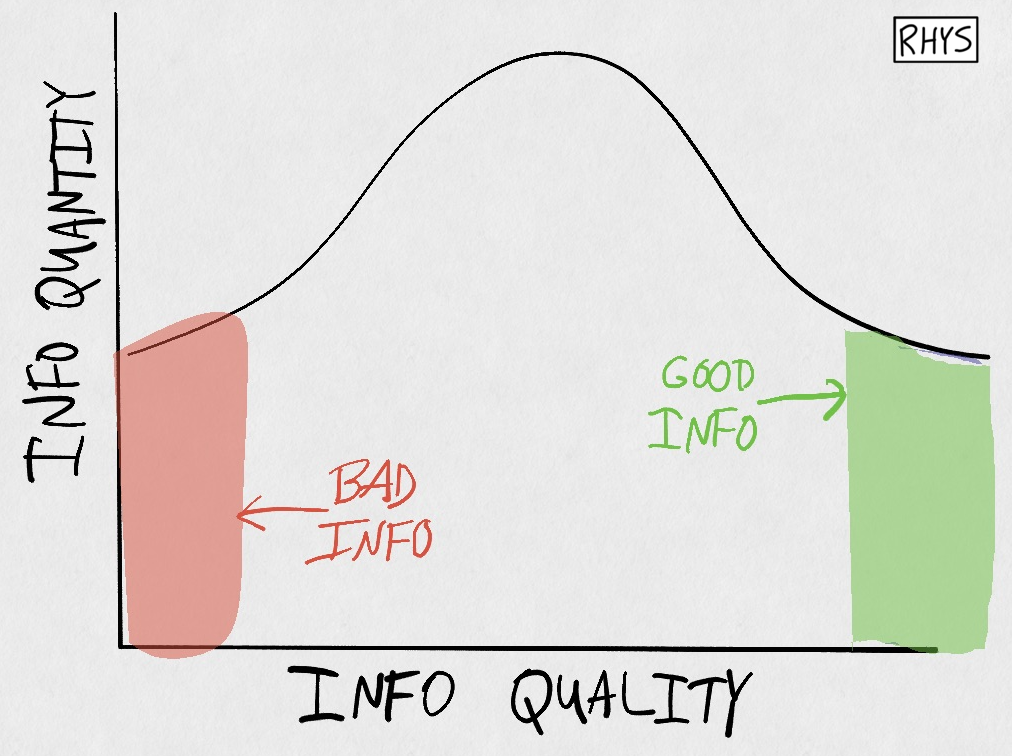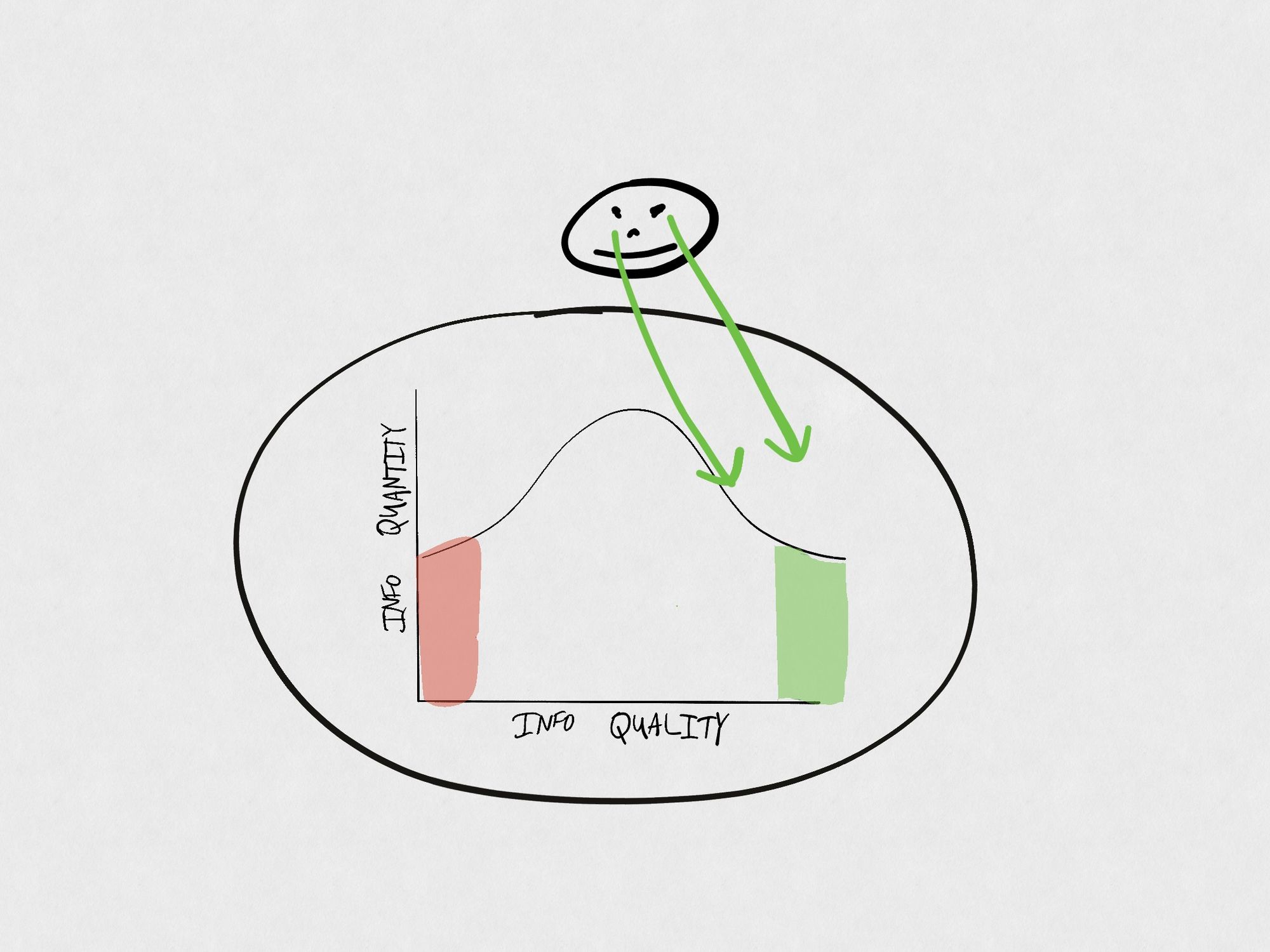Defining Abundance
Let's look at how humanity creates resource abundance, and how we should respond to it. We'll look at:
I. How commoditization creates abundance
II. How abundance increases both quantity and variation in quality
III. How we keep high quality in the face of abundance
I. Commoditization Creates Abundance
Throughout humanity's history, we have used commoditization (or "abstraction") to create Abundance. During the Agricultural Revolution in 10,000 B.C., we started to abstract the process of making food. We developed concepts like "an acre-plot of land" and invented harvesting tools like plows. These abstractions turn food into an "black box commoditized API". We can simply give the "Farming Black Box" it's inputs (like soil, sunlight, water) and receive the outputs (food).

During the Industrial Revolution, a similar abstraction process occurred for physical goods. Assembly line-based factories became a black box that commoditized goods. In 1909, before assembly line production, Ford produced around 11,000 Model T's at a cost of $23,000 per car. By 1925, they were producing nearly 2 million Model T's for only $3,800 per car—a 2,000x increase in production and 6x decrease in price.

During the Information Revolution (happening now), we're seeing a similar abstraction process for information. At the hardware level, electronic bits abstracted information itself into 0's and 1s. Then at the network level, the internet stack (TCP/IP, etc.) abstracted the sharing of information. We can now send any info (in the form of packets of 0's and 1's) to any place (determined by IP address), all at zero marginal cost. Yet another black box.

By creating black boxes to produce food, goods, and information, we now have an abundance of those things.
Abundance Increases Quantity And Variation in Quality
Before we've commoditized the resource, there isn't very much of it. For example, with information before the internet:

Once we've commoditized the resource, it becomes abundant. We can repeatedly trigger the API to get more and more of the thing, and we do. The quantity increases.
However, the quality doesn't universally increase. Instead, we see variation in quality. When the ability to create a resource is democratized, there will be a lot more of it—some good and some bad.

We have more information than ever before, but some of it is misinfo, and some of it is good info.
Here is a similar graph for physical goods:

Like with info, determining what goods are "bad" and "good" is difficult. But as a simple example, you can think of machine guns on the "bad left" and vaccines on the "good right". We can produce a lot of both.
Here is a similar graph for food:

Bad food (burgers, candy, etc.) makes almost half of Americans obese, while good food (spinach, nuts, etc.) keeps us healthy.
These graphs provide us with an opportunity—how can we shift the curve to the right? How can we make all food, goods, and info "good"?
Keeping Quality High in the Face of Abundance
We want to shift the graph to the right. There are two ways to do so:
- Coherent Pluralism is when responsible individuals relentlessly search for the "good" resources.
- Libertarian Paternalism is constructing an environment that lowers the friction for accessing those "good" resources.
Individual's Responsibility: Coherent Pluralism
In an information environment, Coherent Pluralism how individuals relentlessly search for lots of perspectives (Pluralism) while also synthesizing them into clear takeaways (Coherence).
In Ben Thompson's Zero Trust Information, he explains this perspective well:
How much more value might there be in embracing the deluge of information? All available evidence is that young people in particular are figuring out the importance of individual verification; for example, this study from the Reuters Institute at Oxford: Fake news itself is seen as more of a nuisance than a democratic meltdown...users therefore feel capable of taking these issues into their own hands.
Given the underlying dynamic [abstraction --> abundance --> variation in quality], we know that there will be a deluge of information, some of which will be misinformation. Individuals should take the responsibility in weeding out good info from bad.
The image below shows a person who actively searches for the good information:

However, humanity should also make it as easy to find the good as possible. We call this Libertarian Paternalism.
Humanity's Responsibility: Libertarian Paternalism
Libertarian Paternalism was developed by Cass Sunstein and Richard Thaler in 2003. It states that is it "both possible and legitimate for institutions to affect behavior while also respecting freedom of choice."
It is the perfect response to variable-quality abundance. We have a zero-trust information network that moves packets of info in an unopinionated way. Without centralized gatekeepers, we have the "freedom of choice" to access whatever info we'd like. This is the "Libertarian" part.
And, we can affect behavior while still respecting that choice. For example, with organ donation systems: Austria's is opt-out and they have a 99.9% consent rate, while Germany's is opt-in and they only have a 12% consent rate. This is the "Paternalism" part.
Almost all of Sunstein and Thaler's examples are in the realm of behavioral psychology. However, we can expand the scope to be "all defaults and incentives". For example, code defaults are a form of libertarian paternalism. When Apple added an iOS default to track user screen time, it encouraged user reflection for Time Well Spent.
By itself (without Coherent Pluralism), Libertarian Paternalism looks like this:

This shift towards "good quality info" could be created by a whole host of mechanisms: code, laws, norms, financial incentives, and language. It's platforms flagging anti-vaxx conspiracies (a code-based response). But it's also reddit moderators enforcing pro-social comments (a norm-based response).
If we combine Libertarian Paternalism with Coherent Pluralism, it looks like this:

You can imagine similar graphs for food and goods. For example, USDA's new MyPlate helps nudge consumers towards healthier eating habits.
Humanity's future will be increasingly defined by variable-quality abundance. We want an environment that nudges us towards good things (Libertarian Paternalism). And we want individuals take responsibility to consume good things (Coherent Pluralism).
In the next part of this series on Abundance, we'll look at the ongoing shifts in abundance (of money and trust), and how those lead to the concept of Generosity.
Notes:
- imo, Ben Thompson's graph (that I remixed) is one of his highest impact visualizations / concepts since Aggregation Theory.
- Coherent Pluralism is often called "media literacy"
- Coherent Pluralism is an argument against Epistemic Humility
- From this frame, each of these words is roughly synonymous: commoditization, abstraction, protocolization, creating a "wrapper", X-as-a-Service
- The food example makes me think about two issues with variable-quality abundance. First, you can consume bad things (candy). Second, you can consume a lot more of it (lots of candy).
- For Coherent Pluralism, I mostly spoke from an "input" perspective. i.e. What are you doing to be a responsible consumer? But what about "output" as well? i.e. What kind of info are you sharing?
- Coherent Pluralism is demand for good things, while Libertarian Paternalism is supply of good things.
- Sensemaking (in the GameB sense) is roughly synonymous with Coherent Pluralism.
- There's an even more abstracted form of the black boxes that differentiates into atoms, bits, and energy. Farms takes sun energy as input, lets the plant rearrange the atoms, then harvests those atoms for food. Factories take fossil fuels as input energy, rearranges the atoms of raw materials, then uses those atoms for more usable goods. Both take human labor as an input as well.
- Also related: these black boxes show the difference between atoms and bits w/r/t marginal cost. Farms and factories require atoms as input and thus food and goods have marginal costs. The internet only requires electricity as input and thus info is zero marginal cost.
- I mostly concentrated on plant farms here. But there are animal farms as well. 70B factory farmed land animals and 1T sea animals per year.
- The easiest way to determine "what is good" is to check a holistic Bento Box. While most often what "goes wrong" with the right "bad" side is when folks are optimizing for Now Me. (When their limbic system is exploited.) Candy, consumerism, and filter bubble narratives.
- One of the biggest questions/debates is "How can we shift the graph right while still allowing for exit / newcomers?" e.g. Youtube just implemented a policy to takedown anything that is against the WHO. That seems like a good "right-skewing" policy. But there's been a lot of pushback—what about all the things the WHO got wrong? Should we silence info that is correct, but goes against the WHO? (As per Youtube policy.) Fwiw, my opinion is more on the side of "more Libertarian Paternalism". Try to make our defaults "default good" instead of just being completely neutral protocols.
- Right now, we're in an uncanny valley for many of those resources. Imagine pre-internet, when we just had mainstream news. At that time, the graph for something like the NYT was mostly "good/skewed to the right" (not politically, but w/r/t quality). Now though, we had a cambrian explosion of other info. We haven't yet done enough Coherent Pluralism and Libertarian Paternalism to get a right-skewed, high-quality graph again. Soon!
- Good differentation (from wiki) on commodification vs. commoditization. Commodification is wrapping traditionally more "textured" concepts in a value layer so they can be inserted into capitalism. Commodization is creating a perfect market for something. Microprocessors are commoditized. Love is commodified.
- There's an 80-20 rule to Coherent Pluralism. I sent a Twitter link to my dad recently and he was like "I can't believe what most of these replies are saying! They're pretty crazy / wrong." I was like "def Dad, 80% of replies are crap, but 20% are good. Ignore the 80%, focus on the 20%."
Related Articles:
- http://www.paulgraham.com/addiction.html
- https://alexdanco.com/scarcity-in-the-software-century/. Also, this from Alex Danco. Super good work here, especially about the scarcity side of the equation. (What scarcities emerge when abundance is created?)
- Ben Thompson has started to use this framework in other pieces: https://stratechery.com/2020/defining-information/,
- David Perell has some good tips on being a responsible consumer at the bottom of his essay here: News in the Age of Abundance. Also, his graph here shows the shift from scarcity to abundance.
